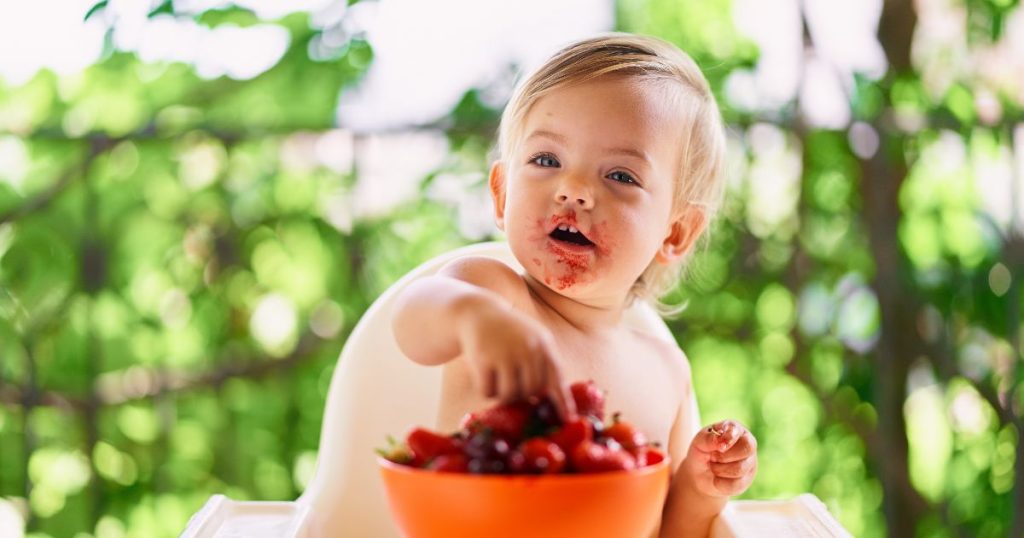Introduction
Baby led weaning foods . Starting your infant on solid foods is a monumental milestone, filled with enjoyment and questions. This method skips traditional purees and spoons in favor of letting your child self-feed with graspable, soft-cooked foods.baby led weaning foods.This detailed guide will walk you through whatever you need to learn about choosing the best baby-led weaning foods. We will explore how to prepare them safely, when to introduce various food groups, and how to develop a well-balanced plate for your growing baby led weaning foods .

Our objective is to supply you with the confidence and understanding to start this feeding experience, making mealtimes a favorable and enriching experience for the entire household.
What is Baby-Led Weaning?
Baby-led weaning is a method of introducing solid foods where babies feed themselves finger foods instead of being spoon-fed purees. The term was popularized by Gill Rapley, a former health visitor and author who observed that infants have a natural ability to control their food intake when provided the opportunity. The core approach of BLW is trusting your baby to lead the method.
From around six months of age, many babies develop the necessary motor skills to sit up, grasp objects, and bring them to their mouths. By using soft, workable pieces of whole foods, you empower your infant to check out, chew, and decide how much to consume.
Is Your Baby Ready for Baby-Led Weaning?
Timing is vital for an effective and safe start to baby-led weaning. The American Academy of Pediatrics (AAP) advises introducing solid foods around six months of age. Before you use that very first piece of avocado or steamed carrot, guarantee your infant shows these crucial indications of developmental preparedness:
Core Developmental Readiness Signs
Can Sit Up Unassisted: Your infant must have the ability to sit upright in a high chair with excellent head and neck control. This stability is essential for safe swallowing and reduces the risk of choking. Their respiratory tract may not be in an ideal position for eating strong foods if they are still dropping over.
Has Lost the Tongue-Thrust Reflex: The tongue-thrust reflex is an involuntary action where an infant pushes food out of their mouth with their tongue. For effective self-feeding, this reflex needs to have actually lessened so they can move food to the back of their mouth to swallow.
Shows an Interest in Food: Does your infant watch you intently while you consume? Do they reach for your food or open their mouth when food is near? This curiosity is a strong indication that they are psychologically ready to explore solids.
The First Baby-Led Weaning Foods: Getting Started
Your child’s very first foods must be soft, easy to comprehend, and nutrient-dense. In the beginning, focus on single-ingredient foods to keep track of for any possible allergic responses.
Best First Foods for 6-Month-Olds
Here is a list of outstanding starter foods, prepared for safe self-feeding:
Fruits:
Avocado: Rich in healthy fats necessary for brain advancement. Serve in thick wedges or spears. It’s naturally soft and simple for little gums to mash.
Banana: A terrific source of potassium and energy. Serve a big piece with some of the peel left on at the bottom to serve as a manage, preventing it from getting too slippery.
Steamed Pears or Apples: Cooking hard fruits until they are really soft is vital. You should be able to mash the fruit easily between your fingers. Serve in wedges.
Mango: Ripe, soft mango can be served on long spears. It can be slippery, so consider rolling it in a bit of baby cereal for a better grip.
Melon: Ripe cantaloupe or honeydew can be used in long, thick pieces. Guarantee it is free and soft or hard rind.
Veggies:
Steamed Carrots: Carrots must be cooked until they are very soft. Serve in finger-sized sticks. Raw or gently cooked carrots are a choking risk.
Sweet Potato: A nutritional powerhouse loaded with Vitamin A. Bake or steam whole, then cut into thick wedges or sticks. The soft texture is best for newbies.
Broccoli and Cauliflower: Steam or roast florets until tender. The “tree” shape makes a great deal for children to hold.
Zucchini or Summer Squash: Steam or roast in spears. When cooked, the skin is edible and soft.
Butternut Squash: Similar to sweet potato, it can be roasted or steamed and cut into workable sticks.
Proteins & Grains:
Toast Sticks: Lightly toasted bread, cut into long strips. You can spread out a thin layer of avocado or saltless butter on it.
Thick Oatmeal: Prepare oatmeal to be thick enough to be scooped with hands or pre-loaded onto a spoon.
Soft-cooked Chicken: Offer chicken prepared until tender, shredded, or served in large, soft strips that children can easily gnaw on.
Flaked Salmon: Salmon is a fantastic source of omega-3 fats. Ensure it is fully cooked and all bones are removed. Offer it in flakes or a larger piece for the baby to break apart.
Lentils and Beans: Cook till very soft and mash them a little. You can serve them on a pre-loaded spoon or as part of a thicker mash that the child can scoop.
Foods to Avoid in the First Year
While variety is encouraged, some foods are ideal or not safe for children under one year of age:
Honey: Can consist of spores of germs that trigger baby botulism, a severe disease.
Cow’s Milk as a Drink: Babies should not have cow’s milk as their main beverage until after age one, as it does not contain the essential nutrients found in breast milk or formula. Small amounts in cooking are great.
Added Salt: An infant’s kidneys are not fully developed to handle the included salt. Avoid processed foods and avoid adding salt to their meals.
Sugarcoated: Sugar provides no dietary worth and can contribute to dental caries and a preference for excessively sweet foods.
Choking Hazards: Hard, round, or small foods like whole nuts, whole grapes, popcorn, hard sweets, and raw veggies.

Understanding Choking vs. Gagging
Among the most significant concerns for parents starting BLW is the fear of choking. It is crucial to comprehend the distinction between gagging, which is a normal and protective reflex, and choking, which is a medical emergency.
What is Gagging?
Gagging is the body’s natural security system to prevent choking. The gag reflex is really delicate in infants and is activated much farther forward on the tongue than in adults. When a piece of food is too large or moves too far back too rapidly, the child will gag to bring the food forward for more chewing.
Signs of Gagging:
Baby’s eyes might water.
They might cough, sputter, or make retching sounds.
Their face might turn red.
They will push the food forward with their tongue.
Gagging is active and loud. It’s an indication that your baby is learning how to handle food in their mouth. The finest thing to do when your baby gags is to remain calm and let them work it out. Stepping in can stun them and potentially turn a gag into a choke.
What is Choking?
Choking is when the respiratory tract is partly or totally obstructed, preventing the child from breathing. It is silent and life-threatening.
Signs of Choking:
Inability to sob, cough, or make any noise.
A panicked or frightened appearance.
Skin may turn purple or blue.
The baby may be clutching at their throat or waving their arms.
Since air can not get past the obstruction, choking is quiet. You must administer infant CPR right away if you suspect your baby is choking. It is extremely recommended that all caretakers and parents take an infant CPR and first-aid course before beginning solids.
Preparing Foods Safely for Baby-Led Weaning
Correct food preparation is the key to lessening the choking threat and making self-feeding effective. The objective is to develop foods that are soft enough for a child to mash with their gums, yet firm enough for them to hold without breaking down.
The “Squish Test”
A basic general rule is the “squish test.” You should be able to squash the food between your thumb and forefinger with ease. This imitates the pressure of an infant’s gums. If you can mash it, it’s likely soft enough for your baby.
Cooking Methods
Steaming: This is among the very best techniques for preparing vegetables and fruits. It softens the food while keeping numerous of its nutrients.
Roasting: Roasting can highlight the natural sweetness in vegetables like sweet potatoes, carrots, and squash. Ensure you don’t roast them until they are crispy or difficult on the outside.
Boiling: While reliable at softening foods, boiling can cause more nutrient loss than steaming. You can use the nutrient-rich water in soups or sauces after cooking.
Baking Is Ideal for preparing items such as custards, soft muffins, or meatloaves.
Food Shapes and Sizes by Age
As your child establishes their grasp and chewing skills will progress. You’ll need to adjust the sizes and shape of the food you provide.
6-7 Months (Palmar Grasp): At this age, babies use their whole hand to pick up items. Food should be cut into long, thick sticks (at least 2 inches long) so that they can be held in the fist and nibbled on the protruding end.
Examples: Avocado spears, sweet potato wedges, broccoli florets with long stems, toast soldiers.
8-10 Months (Pincer Grasp Development): Your baby will start developing the pincer grasp, using their thumb and forefinger to get smaller objects. You can begin to offer smaller, pea-sized pieces of soft food to help them practice this new ability. Continue to provide bigger pieces as well.
Examples: Soft-cooked peas, little pieces of soft fruit, shredded cheese, smidgens of cooked pasta.
10-12 Months (Refined Pincer Grasp): By now, the pincer grasp has improved. Your child is likely a more positive eater and can manage a wider range of textures and sizes. You can begin providing more complex meals and even present utensils like a pre-loaded spoon.
Examples: Cutting food into small cubes, offering forks with soft foods speared on them, serving thicker soups or yogurts that they can scoop.
Constructing a Balanced Plate: Nutritional Considerations
While breast milk or formula remains the primary source of nutrition for the first year, solid foods increasingly play a crucial role in providing essential nutrients, particularly iron.
The Importance of Iron
Children are born with iron stores that start to deplete around six months of age. Iron is critical for brain development and avoiding iron-deficiency anemia. Given that breast milk is low in iron, it’s vital to provide iron-rich foods from the start of your BLW journey.

Iron-Rich Foods for Babies:
Red Meat: Soft-cooked strips of beef or lamb. A big, soft piece of steak that a baby can suck and nibble on is a terrific source of heme iron, which is easily taken in.
Poultry (Dark Meat): Thigh meat from chicken or turkey is higher in iron than breast meat.
Beans and lentils: Offer mashed or in soft patties.
Tofu: A great plant-based source of iron. Serve in soft strips.
Iron-Fortified Infant Cereal: You can mix this into a thick paste or use it to coat slippery foods like avocado or banana.
Leafy Greens: Spinach and kale can be carefully sliced and cooked into omelets or lentil patties.
To improve iron absorption, pair iron-rich foods with foods high in Vitamin C. For example, serve lentils with a side of steamed red bell pepper strips, or provide a piece of orange alongside a soft strip of beef.
Including Healthy Fats
Healthy fats are important for brain development, as the brain is nearly 60% fat. They likewise offer a concentrated source of calories for your active, growing infant.
Sources of Healthy Fats:
Avocado: The perfect BLW food, loaded with healthy monounsaturated fats.
Salmon and Sardines: Oily fish are packed with omega-3 fats (DHA), which are essential for visual and cognitive advancement.
Nut and Seed Butters: Offer smooth nut butters (thinned with a little water or breast milk to avoid it from being a choking danger) spread very finely on toast.
Eggs: The yolk is a fantastic source of choline and fat. Serve as a scramble or as an omelet, cut into strips.
Full-Fat Yogurt: Choose plain, unsweetened, full-fat yogurt.
Introducing Common Allergens
Current suggestions from companies like the National Institute of Allergy and Infectious Diseases (NIAID) recommend introducing typical allergenic foods early, around 6 months of age. Early and routine introduction might help minimize the risk of developing food allergies.
How to Introduce Allergens Safely:.
Introduce one irritant at a time.
Start with a little amount (e.g., a tiny bit of scrambled egg or peanut butter thinned out).
Wait 2-3 days before presenting another brand-new irritant to watch for any response.
Once an allergen is presented and endured, continue to offer it routinely (e.g., several times a week) to help preserve tolerance.
Consult with your pediatrician or a specialist before presenting allergens if there is a household history of food allergic reactions or your infant has severe eczema.
Test Baby-Led Weaning Meal Plan (6-8 Months).
Here’s what a couple of days of meals might appear like for an infant just starting their BLW journey. Remember, these meals are complementary to their regular breast milk or formula feeds.
Day 1.
Breakfast: A thick spear of ripe avocado and a pre-loaded spoon of thick oatmeal.
Lunch: Two large, steamed broccoli florets with long stems.
Supper: A thick wedge of roasted sweet potato and a long, soft strip of slow-cooked chicken thigh.
Day 2.
Breakfast: A long strip of toast with a thin layer of smooth peanut butter (allergen intro) and half a banana with the peel as a handle.
Lunch: An omelet cut into finger-sized strips.
Supper: Flaked salmon and steamed asparagus spears.
Day 3.
Breakfast: Full-fat plain yogurt (irritant introduction) with soft-steamed pear sticks for dipping.
Lunch: Soft-cooked lentil patties (lentils mashed with a little flour or breadcrumbs and pan-fried).
Dinner: A soft beef meatball (large size) and steamed carrot sticks.
Advanced Baby-Led Weaning: 9-12 Months and Beyond.
As your child becomes a more skilled eater, you can expand the variety of textures and foods you offer. They will be much better at moving and chewing food around their mouth.
Broadening Flavors and textures.
Present More Herbs and Spices: Move beyond single-ingredient foods and begin seasoning with moderate herbs and spices like cinnamon, cumin, paprika, oregano, and basil. Avoid spicy spices like chili powder.
Deal Combination Meals: Your infant can now consume modified versions of Family meals. This could include deconstructed tacos (strips of soft tortilla, shredded chicken, mashed avocado, shredded cheese), pasta with a low-sodium sauce, or shepherd’s pie with a soft-cooked ground meat base and mashed potato topping.
Vary Textures: Offer a mix of textures on one plate. For instance, a soft piece of fish, a slightly firmer roasted zucchini spear, and velvety mashed potatoes.
Promoting Utensil Use.
Around 10-12 months, your baby might show an interest in utilizing forks and spoons.
Pre-load Spoons: Load a spoon with yogurt, oatmeal, or mashed foods and hand it to your infant.
Usage Chunky Utensils: Choose baby-friendly utensils with brief, chunky handles that are easy for small hands to grip.
Spear with a Fork: Spear a soft piece of fruit or veggie with a fork and let your infant practice bringing it to their mouth.
Baby-led weaning is a responsive and flexible approach to starting solids. It relies on your child’s inherent abilities and sets the stage for a lifetime of healthy, happy consuming. By concentrating on safe food preparation, providing a range of nutrient-dense foods, and producing a positive mealtime environment, you can direct your child through a delicious journey of discovery.

FAQ.
1. What are the finest first foods for baby-led weaning?
The very best first foods are single-ingredient items that are soft-cooked and cut into long, finger-sized strips. Outstanding choices include avocado spears, roasted sweet potato wedges, steamed carrot sticks, soft-steamed broccoli florets, and a banana with a peel handle. These foods ought to be soft enough to be mashed between your thumb and forefinger.
2. How do I prepare baby-led weaning foods to avoid choking?
Cook all tough fruits and vegetables until they are very soft. Cut foods into shapes that are easy for a child to comprehend but too big to be an obstruction risk —such as thick, long sticks (about 2-3 inches long). Avoid small, hard, round foods like whole nuts, grapes, and hard candies. Constantly monitor your baby throughout meals.
3. When can an infant start baby-led weaning?
An infant is prepared for BLW around 6 months of age, provided they can stay up unassisted, have good head control, have lost the tongue-thrust reflex, and reveal a clear interest in food. Age alone is not the only sign; these developmental turning points are important for safety.
4. Can my infant get enough nutrients with baby-led weaning?
Yes. For the very first year, breast milk or formula is the main source of calories and nutrition. Strong foods are complementary. To ensure adequate nutrition, focus on a variety of foods, particularly iron-rich options such as soft-cooked meats, beans, lentils, and fortified cereals, as well as healthy fats from sources like avocado, salmon, and eggs.
5. How do I present irritants with baby-led weaning?
Administer a small amount of the food and wait 2-3 days to monitor for a reaction before introducing another new irritant. Once tolerated, continue providing the food regularly.
Baby-led weaning is a method of introducing solid foods where infants feed themselves finger foods rather than being spoon-fed purees. By providing soft, manageable pieces of whole foods, you empower your infant to check out, chew, and choose how much to consume. Do they reach for your food or open their mouth when food is near? When a piece of food is too large or moves too far back too quickly, the child will gag to bring the food forward for more chewing.
By focusing on safe food preparation, providing a variety of nutrient-dense foods, and developing a positive mealtime environment, you can guide your child through a scrumptious journey of discovery.
<script type="application/ld+json">
{
"@context": "https://schema.org",
"@type": "BlogPosting",
"mainEntityOfPage": {
"@type": "WebPage",
"@id": "https://redrosebaby.com/"
},
"headline": "12 Best Baby Led Weaning Foods for Healthy Growth",
"description": "Baby led weaning foods . Starting your infant on solid foods is a monumental milestone, filled with enjoyment and questions. This method skips traditional purees and spoons in favor of letting your child self-feed with graspable, soft-cooked foods.baby led weaning foods.This detailed guide will walk you through whatever you need to learn about choosing the best baby-led weaning foods.",
"image": "https://redrosebaby.com/wp-content/uploads/2025/09/baby-led-weaning-foods-5-1024x538.jpg",
"author": {
"@type": "Person",
"name": "Masud Parvez",
"url": "https://redrosebaby.com/about/"
},
"publisher": {
"@type": "Organization",
"name": "Masud Parvez",
"logo": {
"@type": "ImageObject",
"url": "https://redrosebaby.com/wp-content/uploads/2025/09/cropped-red-rose-baby.jpg"
}
},
"datePublished": ""
}
</script>
